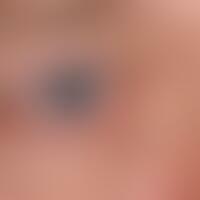Image diagnoses for "Bubble/Blister"
95 results with 373 images
Results forBubble/Blister

Toxic epidermal necrolysis L51.2

Toxic epidermal necrolysis L51.2
Toxic epidermal necrolysis. emergency hospitalization of a highly febrile (temp. 39.5 °C) 78-year-old woman with hemorrhagic, areal, epidermal necrolysis in the area of the left arm after ingestion of vancomycin. significantly reduced general condition. it turned out that the patient had received allopurinol and ampicillin for the first time a few days before.

Toxic epidermal necrolysis L51.2

Toxic epidermal necrolysis L51.2
Toxic epidermal necrolysis. 2 weeks after taking Allopurinol in recurrent attacks of gout, itching and redness on the back for the first time, within a few days dramatic worsening of the general condition with several acute, flat, generalized, randomly distributed, sharply defined, red, weeping and painful erosions. Additional findings were multiple, acute, asymmetrically arranged, disseminated, skin-coloured blisters on a flat erythema on the remaining integument.

Toxic epidermal necrolysis L51.2
Toxic epidermal necrolysis. detailed view of a solitary, acutely occurring, perimamillary, sharply defined, slightly weeping, extensive, erosive detachment of the skin. the sample biopsies showed a vacuum-associated interfacial dermatitis with epidermal keratinocyte necroses.

Toxic epidermal necrolysis L51.2
Toxic epidermal necrolysis. detailed picture: The 67-year-old female patient developed multiple, acute, disseminated, sharply demarcated, partly confluent, soft, skin-coloured blisters on a flat erythema on the entire integument within a few days. In case of persistent fever, antibiotic therapy was initiated.

Toxic epidermal necrolysis L51.2
Toxic epidermal necrolysis. mostly picture of erythema exsudativum multiforme. necrolytic detachment of the skin beginning at the knee and lower leg.

Contact dermatitis allergic L23.0
Acute allergic contact dermatitis: 6 days ago, the first acute, itchy, blurred erythema on the left wrist with blistering after wearing a metal bracelet.

Erysipelas bullous
Erysipelas bullöses: extensive, sharply defined, painful redness and plaque formation in the area of the lower leg. entrance portal: macerated tinea pedum. secondary findings include fever and chills, lymphangitis and lymphadenitis.

Erysipelas bullous
Erysipelas, bullous: acute , sharply limited, flat redness of the lower leg under high fever with extensive hemorrhagic blistering.

Hand-foot syndrome T88.7
Hand-foot syndrome: acute, drug-induced, painful erythema in the palmar and plantar area; typical drug history for anthracyclines (doxorubicin).

Vascular malformations Q28.88
Malformations, vascular, lymphatic malformation: " Lymphangioma circumscriptum"

Vascular malformations Q28.88
Malformations vascular. Venousmalformation. Suction. "Angiokeratoma scroti et vulvae".

Small vessel vasculitis, cutaneous L95.5
Vasculitis of small vessels. leukocytoclastic vasculitis (non-IgA-associated vasculitis)

Small vessel vasculitis, cutaneous L95.5
Vasculitis of small vessels. leukocytoclastic vasculitis (non-IgA-associated vasculitis)

Dyshidrotic dermatitis L30.8
Cheiropompholyx: Large vesicular dyshidrotic eczema (Cheiropompholyx) occurring within 2 days in a 42-year-old patient with recurrent attacks of mild vesicular dyshidrotic eczema. An atopic diathesis is known.

Herpes simplex recidivans B00.8
Herpes simplex recidivans: recurrent, in this case very extensive, multilocular herpes simplex infection in an HIV-infected person at intervals of 6-8 months

Apocrine hidrocystoma L75.8
Hidrocystoma, apocrine: Merely cosmetically noticeable and disturbing blue discoloration due to previous bleeding, so called "Hidrocystome noire".

Apocrine hidrocystoma L75.8
Apocrine hidrocystoma in typical localization, translucent cyst "sitting on" the lower lid.

Apocrine hidrocystoma L75.8
Apocrine sweat gland cysts at the medial lower lid margin; conglomerated, translucent, completely asymptomatic cysts.

Hand-foot syndrome T88.7
Hand-foot syndrome: after chemotherapy. grade 3: extensive blistering; oozing, coarse lamellar desquamation; ulcerations, severe pain. considerable discomfort that makes everyday business impossible.

Hand-foot syndrome T88.7
Hand-foot syndrome: after chemotherapy. grade 3: extensive blistering; oozing, coarse lamellar desquamation; ulceration, severe pain.

Hand-foot syndrome T88.7
Hand-foot syndrome: after combined chemotherapy. grade 3: extensive blistering; oozing, coarse lamellar desquamation; ulcerations, severe pain; considerable discomfort that makes everyday business impossible.

